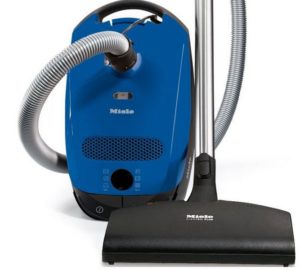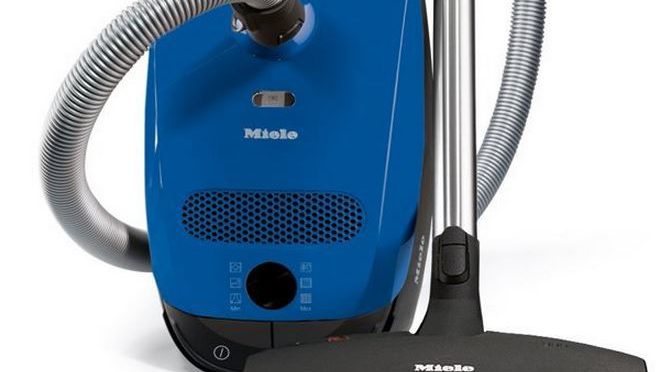
We’ll be blunt: Miele no longer makes the Miele Classic C1 Delphi . In order to promote the C3 canisters (e.g., vacuums like the Alize and Calima), production ended in April 2017. However, just because it’s no longer in production doesn’t mean it’s any less of a vacuum. It’s still one of the best canisters you’re going to find for under $500, and it includes something you’ll be hard-pressed to find on most of their current models without spending several hundred more: an electric powered cleaning brush. Today we’re going to answer some frequently asked questions about the Delphi, including how it stacks up to what Miele describes as its replacement, the Compact C2 Electro+. We recently did a similar comparison involving the Classic C1 Titan that you can read here.
Which filters and dust bags do I need to replace those on the Delphi, and when do I change them?
You’ll need GN-sized dust bags and filters for the Delphi, such as those packaged in the Miele GN Airclean 3D Efficiency Dust Bag. You’ll find four dust bags, an air filter, and a motor filter in each box. You’ll want to replace the dust bags whenever they’re full and the motor filter after each box’s worth of bags. Instead of using the cheap air filter, we’d recommend the Miele HEPA AirClean SF-HA 50; it’s a HEPA filter that will last for 50 hours of vacuuming, or a year of typical use. It’s a good idea to buy several dust bags and HEPA filters at once so you aren’t forced to pay extra for shipping when you realize you’re out of bags and your current one is bursting at the seams.
Compared to the Electro+, is the Delphi better or worse overall and for carpets and hardwood floors?
While the Classic C1 Titan is easily a match for the Electro+, we’d have to give the edge to the Electro+ when compared to the Delphi. It’s not that the Delphi is a bad vacuum cleaner, because it isn’t. It’s a solid machine, as is the Electro+. The difference is in the accessories and in what they let you do. Since both are equipped with electrobrushes (the SEB 217-3 in the Delphi and the SEB 228 in the Electro+), both can handle low-pile, medium-pile, and several high-pile carpets. However, because only the Electro+ has the SBB Parquet-3 Floor Brush, it’s going to do a better job when it comes to effectively and safely cleaning a hardwood floor. The electrobrush won’t damage it; it’ll just be noiser and require more work than the Parquet head. And of course, you could buy a separate Parquet head for the Delphi, but if you’re going in that direction, it would be cheaper to just get the Electro+.
What other differences exist between the Delphi and the Compact C2 vacuums like the Electro+?
There are other differences to keep in mind too, but they aren’t nearly as significant. Because the Delphi is a full-sized Miele, you’ll be able to store all of your accessories (small cleaning brushes) on the canister, as well as use larger cleaning bags. The Electro+ takes smaller bags and can’t fit accessories and tools inside it. The total operating radius (your effective reach) is also different; this is actually better in the Compact C2 than in the Classic C1 line (33 feet vs 29.5 feet). That said, these differences aren’t deal breakers for most people.
Is it worth spending extra to get the Titan over the Delphi?
As we noted in our review comparing both, the answer to this question depends entirely on whether or not you want the Parquet brush and a HEPA filter from the start instead of needing to buy both separately. If you’re happy with how your electro brush cleans your bare floors and you don’t need HEPA filtering, there isn’t really a reason to get the Titan besides being a fan of the color red.
Are the new C1s, C2s, and C3 Mieles that much better than the C1 Delphi?
It depends on what you mean by “better.” We’re of the opinion that the Classic C1 doesn’t clean any worse simply because Miele decided it was time to make more money with more models; they’re still some of the best vacuums ever created in our books. That said, the Compact C2 Electro+ does have a few notable advantages over the Delphi as noted above. Compared to the Compact C1, the Delphi comes out on top; the Compact C1 is the new budget line and doesn’t offer anything you can’t get in the Delphi besides a lighter weight, and there are very few people who find Miele canisters too difficult to move.
The comparison to the C3 line is more complex. The C3s have a longer reach due to longer components. The higher end models, such as the Brilliant and Marin, include automatic modes to adjust power on the fly without any work on your part. They’re also based on sealed systems, which is a significant advantage for families with allergies, as they’re going to keep more contaminants in, resulting in fewer allergens floating throughout your environment. All of the C3s with electric brush heads also include Parquet heads, and several of them, including the Cat & Dog, the Kona, and the Soft Carpet, cost under $1,000 while offering slightly more advanced electric brush heads than those in the Delphi or other Classic C1s. That said, you can live without any of these upgrades, and if your goal is simply to have a good vacuum for a low price, you’ll be served well with Delphi.
![]() You can buy the Miele Classic C1 Delphi here on Amazon. For a few dollars more, you can buy the Compact C2 Electro+ here. Both do a great job with electro brushes; it’s really a question of whether you want a vacuum with a larger capacity (the Delphi) or a lighter one with a Parquet head (the Electro+).
You can buy the Miele Classic C1 Delphi here on Amazon. For a few dollars more, you can buy the Compact C2 Electro+ here. Both do a great job with electro brushes; it’s really a question of whether you want a vacuum with a larger capacity (the Delphi) or a lighter one with a Parquet head (the Electro+).
![]() Canadians unfortunately can’t buy the Delphi, but you can buy the Titan here or buy the Electro+ here.
Canadians unfortunately can’t buy the Delphi, but you can buy the Titan here or buy the Electro+ here.
 If you find our research on PMC helpful, you can follow our efforts to keep maniacally reviewing home cleaning tools by shopping through our links above. We promise to keep fighting the good fight against every horror children, animals, and grown, yet messy humans can inflict upon a clean home.
If you find our research on PMC helpful, you can follow our efforts to keep maniacally reviewing home cleaning tools by shopping through our links above. We promise to keep fighting the good fight against every horror children, animals, and grown, yet messy humans can inflict upon a clean home.

